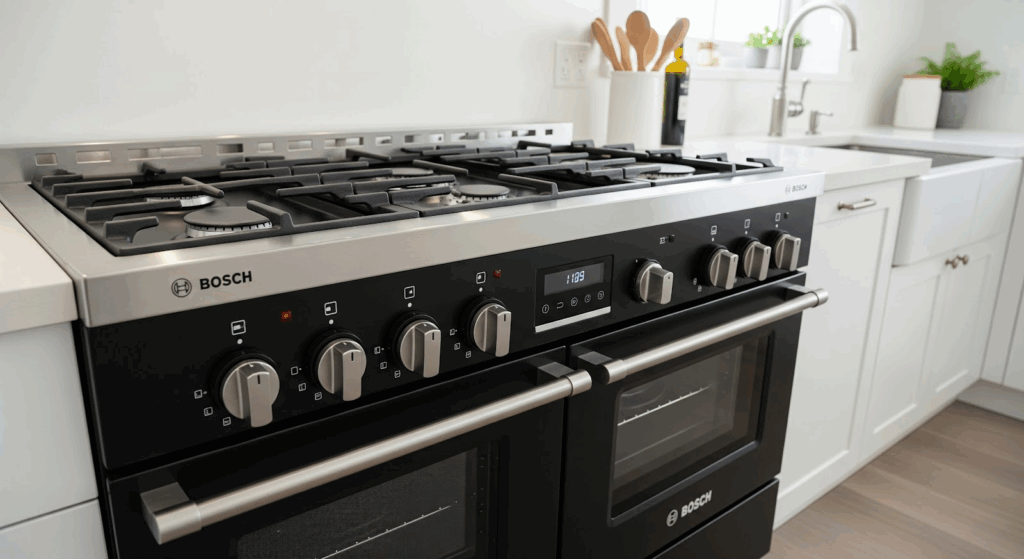
If your Bosch gas range isn’t igniting properly—no clicking sound, no sparks—you might have a faulty spark module. This small but essential component controls the ignition of your burners, and when it fails, your stove won’t light.
The good news? Replacing the spark module is a straightforward fix you can do yourself with the right tools and safety precautions. Follow this step-by-step guide to get your stove working again.
Common Mistakes to Avoid
Replacing a spark module is relatively simple, but some mistakes can cause issues during installation or operation. Avoid these errors:
- Forgetting to Cut Power and Gas: Always disconnect both to prevent electric shock or gas leaks.
- Not Checking Compatibility: Using the wrong spark module may not fit properly or work correctly.
- Forcing Components: Wires and connectors should be handled carefully to prevent damage.
- Skipping Wire Labeling or Photos: Misplacing or incorrectly reconnecting wires can prevent the burners from igniting.
- Over-Tightening Screws: This can crack the module or strip the screw threads, making removal difficult later.
- Ignoring Other Possible Issues: If only one burner isn’t working, the igniter might be faulty instead of the module.
Avoiding these mistakes will help the replacement process go smoothly and prevent further issues.
Tools & Materials You’ll Need
Before you begin, gather these essentials:
- Replacement spark module (00753257) – Make sure it’s compatible with your specific Bosch range model.
- 13/16-inch socket wrench
- Phillips screwdriver
Safety First
Safety should be the top priority any time you work on an appliance. Here are some key precautions to follow:
- Turn Off Power: Unplug the stove or switch off the circuit breaker to avoid electric shock.
- Shut Off the Gas Supply: This prevents any leaks while you work.
- Let the Appliance Cool: If the range was recently used, give it time to cool completely before starting.
- Use the Right Tools: Avoid using makeshift tools that could damage components or cause injury.
- Work in a Well-Lit Area: Proper lighting makes it easier to see and handle small parts.
- Keep Kids and Pets Away: Keep the workspace free from distractions and hazards.
- Wear Insulated Gloves: Protect your hands from sharp edges and electrical components.
- Take Photos Before Disconnecting Wires: This makes reassembly much easier.
How to Replace the Spark Module in a Bosch Gas Range
Follow these steps to safely remove the old spark module and install a new one in your Bosch gas range.
Preparation
- Unplug the range from the power outlet and shut off the gas supply.
- Lift the burner caps off each burner and set them aside.
- Use a 13/16-inch socket wrench to unscrew and remove the nuts securing the burner bases.
- Pull the cooktop forward to expose the internal components.
Removing the Old Spark Module
- Locate the spark module cover and remove the Phillips screws securing it.
- Take off the cover and set it aside.
- Locate the small screw securing the plug and remove it using a Phillips screwdriver.
- Keep the plastic washer for later use.
- Observe how the wires are connected to the old spark module, noting their color codes.
- Disconnect the red, white, orange, and black wires from the old spark module.
Installing the New Spark Module
- Slide the new spark module under the plastic washer.
- Reconnect the red wire (S1) to the red terminal, the white wire (S2) to the white terminal, the orange wire (S3) to the orange terminal, and the black wire (S4) to the black terminal.
- Use a Phillips screwdriver to tighten the securing screw and hold the new spark module in place.
- Swing the tab onto the spark module and tighten the screw.
Reassembling the Range
- Align the spark module cover with the cutouts and secure it with the Phillips screws.
- Lower the cooktop back into position, keeping the wires properly connected and with enough slack.
- Reassemble the burner bases by orienting them correctly and securing them with the nuts using the 13/16-inch socket wrench.
- Align the burner caps onto the burners and press them into place.
Final Testing
- Plug the range back into the power outlet.
- Turn the gas supply back on.
- Turn on the burners and check that they ignite properly.
- If the burners do not spark, check the wiring connections.
- Listen for the clicking sound when igniting the burners.
Read More: How to replace spark switch 00189008 on a Bosch range
Maintaining Your Gas Range Ignition System
To extend the lifespan of your new spark module and keep your gas range working efficiently, follow these maintenance tips:
- Clean Burner Heads Regularly: Grease and debris can block the burner ports and affect ignition.
- Check for Loose or Disconnected Wires: Periodically inspect the wiring connections to prevent ignition failures.
- Avoid Spills Around the Ignition System: Liquid spills can cause electrical shorts or interfere with the spark module’s performance.
- Test All Burners Periodically: Igniting each burner regularly can help catch issues early.
- Listen for Unusual Sounds: Constant clicking or weak sparks might indicate a developing problem.
- Use a Surge Protector: Power surges can damage the spark module over time.
- Replace Worn-Out Parts Promptly: Igniters and other ignition components wear out over time, so replace them when needed.
What’s Next?
If your stove wasn’t sparking before, it should be working now—no expensive service call, no waiting around for a repair. A bad spark module can stop your kitchen in its tracks, but swapping it out is easier than you might think. The key? Take your time, connect the wires carefully, and use the right tools.
But fixing one part doesn’t mean the job is done. Keeping your ignition system clean and in good shape helps prevent future problems. Wipe down the burners, check the wires now and then, and don’t ignore strange clicking sounds.
